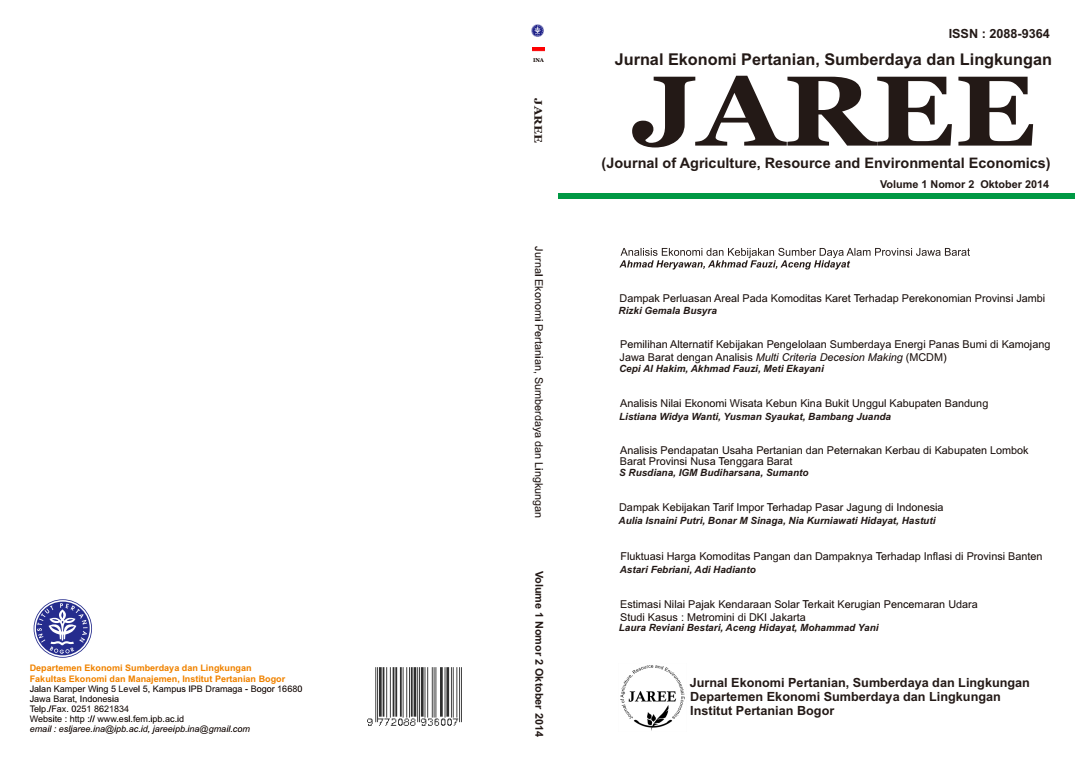DAMPAK KEBIJAKAN TARIF IMPOR TERHADAP PASAR JAGUNG DI INDONESIA
Abstract
Maize is the second largest contributor to GDP after rice in the food crops subsector in Indonesia. The domestic maize production is unable to meet the high demand. Therefore, there is a gap or imbalance between supply and demand and maize import cannot be avoided. The implementation of ASEAN Free Trade Area has reduced and eliminated tariff barriers. The objectives of the study are to: (1) identify factors that affect the supply and demand for maize, and (2) analyze the impact of changes in maize import tariff on the supply, demand, and welfare of producers and consumers of maize in Indonesia. The study used time series data from 1986-2010. Indonesian Maize Trade model is constructed as a system of simultaneous equations and estimated method using Two Stage Least Squares (2SLS).The elimination of Indonesian maize import tariff from AFTA or non AFTA countries is leading to decreased producer surplus. Therefore, the combination of eliminating Indonesian maize import tariff from AFTA and non AFTA countries, decreasing the retail price of urea fertilizer, and increasing maize prices at the farm level can compensate the decrease of producer surplus so that the welfare can be increased(net surplus).Downloads
References
Badan Pusat Statistik. 2011. Statistik Pertanian. Badan Pusat Statistik, Jakarta.
_________________. 2012. Luas Panen, Produktivitas, dan Produksi Tanaman Jagung Indonesia. http://www.bps.go.id/tnmn_pgn.php?kat=3. diakses pada tanggal 28 Desember 2012.
_________________. 2013. Impor menurut Komoditi. http://www.bps. go.id/exim-frame.php?kat=2. diakses pada tanggal 20 Agustus 2013.
Dermoredjo, S. K., Masyhuri, D. H. Darwanto, dan J. H. Mulyo. 2012. Kajian Ketersediaan Jagung dan Kedelai dalam Rangka Menghadapi Perdagangan Bebas: Kasus Negara-negara ASEAN. Jurnal Sosial Ekonomi Pertanian dan Agribisnis, 8 (2): 51-182.
Erwidodo, Hermanto, dan H. Pudjihastuti. 2003. Impor Jagung: Perlukah Tarif Impor Diberlakukan? Jawaban Analisis Simulasi. Jurnal Agro Ekonomi, 21 (2): 175-195.
Hapsari, T. D., M. Muslich M., N. Hanani A. R., dan R. D. Astuti. 2009. Dampak Konversi Jagung sebagai Etanol di Pasar Dunia terhadap Ketersediaan Jagung di Indonesia. Jurnal Agro Ekonomi, 27 (1): 193-211.
Kariyasa, I. K. dan B. M. Sinaga. 2004. Faktor-faktor yang Mempengaruhi Perilaku Pasar Jagung di Indonesia. Jurnal Agro Ekonomi, 22 (2): 167-194.
Kementerian Pertanian. 2010.Menuju Kebijakan HPP Jagung Mendukung Stabilitas Harga: Masih Perlukah?.http://www.pse.litbang.deptan.go.id/ind/pdffiles/anjak_2010_08.pdf. diakses pada tanggal 23 September 2013.
Koutsoyiannis, A. 1977. Theory of Econometrics: An Introductory Exposition of Econometric Methods. Second Edition. The Macmillan Press Ltd, London.
Pindyck, R. S. and D. L. Rubinfeld. 1998. Econometric Models and Economic Forecasts. Fourth Edition. McGraw-Hill Inc, Boston.
Sarasutha, I. G. P. 2002. Kinerja Usaha Tani dan Pemasaran Jagung di Sentra Produksi. Jurnal Litbang Pertanian, 21 (2): 38-47.
United States Department of Agriculture. 2012. Indonesia Corn Total Supply by Year.http://www.indexmundi.com/agriculture/?country=id&commodity=corn&graph=total-supply. diakses pada tanggal 29 Desember 2012.




